Mystras and Sparta are only 5km apart and both teem with ancient history.
The towns are located at the foot of the Tygetos mountain range in a fertile valley studded with olive trees as far as the eye can see.
The archaeological site of Mystras became a UNESCO World Heritage Site in 1989.
In the 13th Century, some 20.000 people lived in the town that clings to the side of a 300m hill, which is topped by a relatively well preserved castle.
Sparta was founded around 900 BC and became an important city-state. 650BC, it rose to become the dominant military land power in ancient Greece.
The city was unique in the empire for its social system and constitution.
Spartiate men underwent a rigorous training program from the age of seven until the turned 21.
When a Spartan man went to war, his wife (or another woman of some significance) would customarily present him with his shield and say: "With this, of upon this." Meaning, he could either come back alive or dead, being carried on his shield. There were no wounded Spartans coming home.
 |
| The 3rd Century Spartan theater with the new town in the background |
Free Spartan women enjoyed considerably more rights than elsewhere in classical antiquity, some even learned how to read and write!
The story depicted in the movie "300" did apparently happen for real in 480BC, when King Leonidas led a small army of 300 true Spartiates and around 1000 other man mad a legendary last stand at the Battle of Thermopylae against the massive Persian army, led by Xerxes.

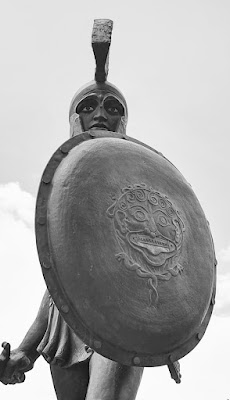
King Leonidas
After this healthy dose of old stones, we moved into the hills a bit so my human could go for a refreshing 15km hike through the Skiritida Forest.
 |
Yet another gorgeous spot for the night
|
The next day, we had a look around Nafplio, Argos and Akrokorinth.
Argos is one of the oldest continuously inhabited cities in the world and the oldest in Europe.
And Nafplio was the first capital of the newly born Greek state between 1823 to 1834.
What binds these places together is, of course, ruins of formerly great cities that had been around for many centuries.
 |
| Nafplio |
 |
| Larissa Castle above the city |
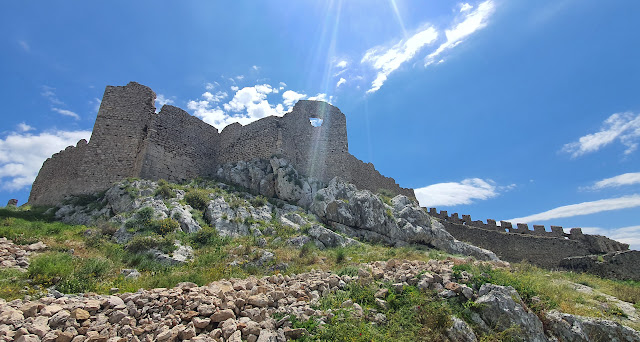 |
| Castle of Agros |
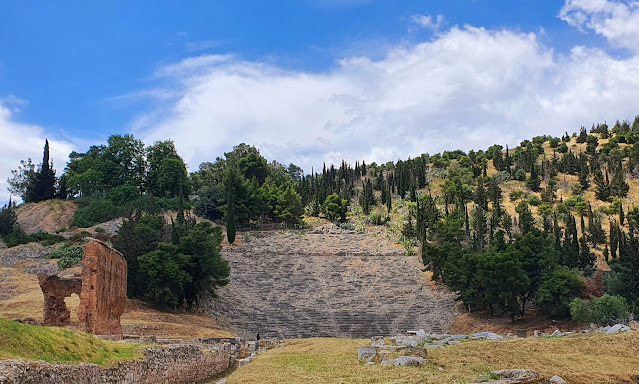 |
| The ancient theater of Agros |
 |
| Modern Agros |
Sometimes the backside is the more interesting one; what a booty! Sorry, Hercules!
 |
| Akrokorinth; ledgend has is that the first settlement established on the foot of the Akrokorinth was founded by King Sysyphos. |
 |
| The Temple of Apollo |
 |
| Masterful structural engeneering |
 |
| 6th Century BC |
 |
| Remains from a cemetery that were in use from the 6th to the 4th Century |
 |
| Not too sure if the artist got payed or hanged |
Do you remember me telling you about the Canal of Corinth?
Well, now I can present some photos. The bridge you see is actually submersible, the center span can be lowered to 8m under the waters surface.
 |
| Before they built the canal, ships were pulled out of the water and moved along on wheeled cradles. |
 |
| Our guard dog the previous night; not sure how useful she would have been if needed. |
And now it was time for the big one - Athens!
The capital of Greece beckoned and we heeded the call! The call of more ancient ruins than anyone can possibly look at (or pay for to look at) in a few short days.
After having stationed ourselves in a secure, if not pretty, spot in an industrial area next to loads of busses and trucks, my human first went to check out Piräus.
The city was founded in the early 5th Century BC and enjoyed an important status as the port of Athens.
During the Golden Age of Athens, long walls were built to secure the route from the port to the main settlement, 8km away.
From the 3rd century onwards, Piräus went into a decline and only revived in the 19th Century, when Athens became the capital of the country.
Today, the port is the 5th largest in Europe. Some six million cargo containers get moved through, as well as five million passengers.
 |
| View from Piräus to the greater Athens area |
 |
| Karaiskakis Stadium, home of Olympiakos Piräus |
Saint Spyridon church A rather malnourished lion
 |
| I don`t think MisoMiso will open again any time soon... |
Since we don`t really keep too much track of dates, we were somewhat blindsided by the fact that the following day was the first of May, a public holiday, on which almost everything would be closed and some strikes were due to take place. This included the Metro lines for most of the day.
Moving around just became a little bit more difficult.
To accommodate for delays, my human left with plenty of spare time to make it to her walking tour around the center of Athens.
One of the many monuments the group visited during the tour stood out for her.
Hadrian`s Gate, built in 131 AD, is a mix of two building styles, with the lower part displaying Roman architecture, whereas the upper part is clearly Greek.
Hadrian, who came to Greece to rule in the name of the Roman Empire, was an admirer of the Greek philosophers and architects and, contrary to his predecessors, didn`t strive to enlarge the empire by submission.
He granted Greeks equal representation in Rome and in return was presented with Athenian citizenship.
 |
| Right behind Adrian`s Gate are the remains of the Temple of Olympian Zeus, at it`s time (2nd Century BC), the largest temple in Greece, with 104 columns |
 |
| The stadium built for the first modern Olympic Games in 1896, 50.000 seats |
 |
| The only stadium in the world built entirely of marble and place of the handover ceremony of the Olympic flame to the host nation. |
 |
| Hadrian`s library |
 |
| The Parliament |
Change of the guards; please appreciate the shoes!
 |
| The Acropolis from the Philosopher´s hill |
 |
| The Roman Agora (a public open space used for assemblies and markets) |
 |
| Tower of the Winds |
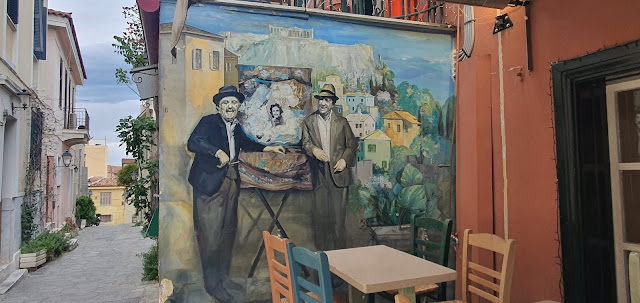 |
| A bit more modern, this piece of art |
 |
Plaka neighbourhood
|
Highly visible from all over the city, sits the Acropolis on a flattish rock that rises 150m above sea level and some 60m above the surrounding neighborhoods.
Acropolis translates to "the highest point in town", which is why you will find an Acropolis in almost any town or city of a certain size in Greece.
The hill was inhabited as early as the 4th millennium BC, but it was Pericles, in the 5th Century BC, who coordinated the construction of the buildings which can still be seen (in parts, at least) today.
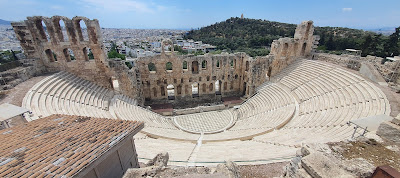 |
| Odeion of Herodes Atticus |
 |
| The Parthenon |
 |
| Temple of Athena Nike |
 |
| A 13m high statue of Athena, made of marbel and ivory, stood on the pedestal rocks still visible in front of the temple. |
Although people would live in caves and dwellings surrounding the Acropolis, making good use of the many fresh water springs available, the actual top of the hill was almost exclusively dedicated to worship.
First among the gods worshipped was Athena, of course. Before becoming patron saint, she had a fight with Poseidon for command of the city. Poseidon struck the ground with his trident and brought forth water. Athena planted a seed which immediately grew into an olive tree. The people chose Athena as their ruler.
Many turbulent centuries under varying swayers followed.
Most buildings were seriously damaged during the 1687 siege by the Venetians when gunpowder stored in the Parthenon by the then Turkish rulers was hit by Venetian bombardment and exploded.
 |
| Model of the Acropolis as it would have appeared in the 5th Century AD |
 |
| Model of the Parthenon |
The Acropolis Restoration Project began in 1975 and is still ongoing today, aiming to preserve the surviving structures and to curb the damaging influences of attrition and pollution.
Today, some 9 million people visit the Acropolis every year. To my human it seemed like at least 10% were there with her.
 |
| Impressions from the Acropolis Museum |
One of the two was definitely luckier than the other
Parts of a smaller copy of the 13m Athena statue
 |
| This is the eyelid of a statue (please imagine the size of the statue) |
 |
| "Megakles is good looking" says the inscription on the top |
Financial records
 |
| In this area you are not allowed to take pics, mainly because of one of the museum`s greates treasures: |
 |
| This statue of Athena (photo taken from far away, sorry for it being a bit grainy) |
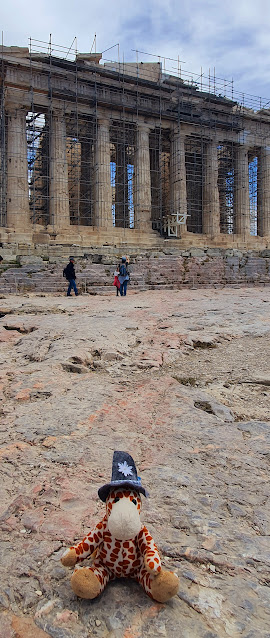 |
| Almost forgot, Carmelo was at the Parthenon, too, of course! |

































































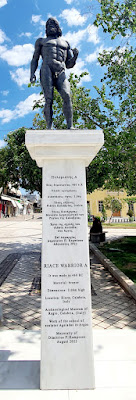




































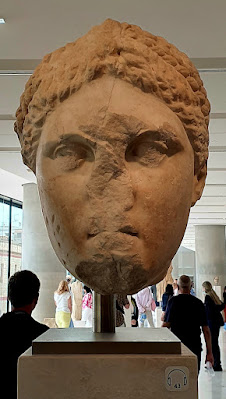













Comments
Post a Comment